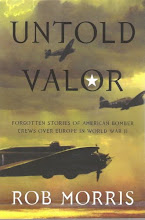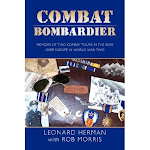


Since tomorrow is Martin Luther King, Jr. Day, I thought it fitting to have a short story on the segregation of the armed forces in World War Two, and some black ambassadors who helped prove that a black American could fly and fight as well as any white man. These ambassadors were the Tuskegee Airmen.
Starting in 1941, the Army Air Force began training black Americans as military pilots in Alabama at Tuskegee's Moton Field and Tuskegee Army Air Field.
They flew escort and combat missions throughout the Mediterranean Theater of Operations, and were collectively known as the Tuskegee Airmen. They flew 200 missions as heavy bomber escort without losing a single bomber to enemy fighter opposition. The 332nd Fighter Group comprised the largest fighter unit in the 15th Air Force.
The Tuskegee airmen flew over 300 missions for the 15th Air Force, distinguishing themselves in battle and crushing the stereotype that black men could not fly.
On the eve of Martin Luther King Jr.'s birthday, I salute these brave Americans.
The combat record of the Tuskegee Airmen
speaks for itself:
· Over 15,000 combat sorties (including 6000+ for the 99th prior to July '44)
· 111 German airplanes destroyed in the air, another 150 on the ground
· 950 railcars, trucks, and other motor vehicles destroyed
· 1 destroyer sunk by P-47 machine gun fire (Lt. Pierson's flight)
· Sixty-six pilots killed in action or accidents
· Thirty-two pilots downed and captured, POWs
· NO U.S. bombers lost while being escorted by the 332nd, a unique achievement
· 150 Distinguished Flying Crosses earned
· 744 Air Medals
· 8 Purple Hearts
· 14 Bronze Stars
Statistics and Decorations of the
Tuskegee Airmen
Total Missions:
12th Air Force
1267
Total Missions:
15th Air Force
311
Total Sorties:
12th Air Force
6381
Total Sorties:
15th Air Force
9152
Combat Tally
Aircraft (aerial)
136
Aircraft (ground)
237
Barges &
Boats
40
Box cars, Other
Rolling Stock
619
Buildings
Factories
23
Gun Emplacements
3
Enemy
Warships
1
Horse Drawn
Vehicles
115
Motor
Transports
87
Power
Transformers
5
Locomotives
Trains
126
Radar
Installations
9
Tanks on Flat Cars
7
Oil & Ammunition
Dumps
2
Decorations
Legion of Merit
1
Silver Star
1
Soldier Medal
2
Flying Cross
150
Purple Heart
8
Bronze Star
14
Air Medal
744
Air Victories
Aircraft used by U.S. pilots is indicated in BLUE
Enemy Aircaft destruction is indicated in RED
Lt. Clarence Allen (99th FS)
1 FW 190 (Destroyed, shared with Capt. Baugh Jan. 27, 1944 P-40)
Capt. Lee Archer (302nd FS)
1 ME 109 (Destroyed July 18, 1944 P-51);
1 ME 109 (Destroyed July 20, 1944 P-51);
3 ME 109s (Destroyed Oct. 12, 1944 P-51)
Lt. Willie Ashley Jr. (99th FS)
1 FW 190 (Damaged June 9, 1943 P-40);
1 ME 109 (Probable June 18, 1943 P-40);
1 FW 190 (Destroyed Jan. 27,1944 P-40)
Lt. Charles Bailey (99th FS)
1 FW 190 (Destroyed Jan. 27, 1944 P-40);
1 FW 190 (Destroyed July 18, 1944 P-51)
Capt. Howard Baugh (99th FS)
1 FW 190 (Destroyed, shared with Lieut. Allen Jan. 27, 1944 P-40)
1 FW 190 (Damaged Jan. 27, 1944 P-40)
Lt. Rual Bell (100th FS)
1 FW 190 (Destroyed March 31, 1945 P-51)
F/O Charles Brantley (100th FS)
1ME 262 Jet (Destroyed March 24,1945 P-51)
Lt. Thomas Braswell (99th FS)
1 FW 190 (Destroyed March 31, 1945 P-51)
Capt. Roscoe Brown (100th SF)
1 ME 262 Jet (Destroyed March 24, 1945 P-51);
1 FW 190 (Destroyed March 31, 1945 P-51)
Lt. John Briggs (100th FS)
1 ME 109 (Destroyed August 24, 1944 P-51)
Lt. Milton Brooks (302nd FS)
1 ME 109 (Destroyed Oct. 12, 1944 P-51)
Capt. Charles Bussey (302nd FS)
1 ME 109 (Destroyed June 9, 1944 P-47)
Maj William Campbell (99th FS)
2 ME 109s (Destroyed March 31, 1945 P-51)
Note: Some records indicate 1 kill.
Lt. Carl Carey (301st FS)
2 ME 109s (Destroyed April 1, 1945 P-51)
Capt. Lemuel Custis (99th)
1 FW 190 (Destroyed Jan. 27, 1944 P-40)
Capt. Alfonso Davis (99th FS)
1 Macchi 205 (Destroyed July 16, 1944 P-51)
Lt. John Davis (99th FS)
1 ME 109 (Destroyed March 31, 1945 P-51)
Lt. Robert Diez (99th FS)
1 FW 190 (Destroyed Jan. 27, 1944 P-40);
1 FW 190 (DestroyedJan. 28,1944 P-40)
Capt. Elwood Driver (99th FS)
1 FW 190 (Shared Probable Jan. 27, 1944 P-40);
l FW 190 (Destroyed Feb. 5, 1944 P-40)
Lt. Wilson Eagleson (99th FS)
1 FW 190 (Destroyed Jan. 27, 1944 P-40);
1 FW 190 (Destroyed July 20, 1944 P-40)
Lt. John Edwards (301st FS)
2 ME 109s (Destroyed April 1, 1945 P-51)
Capt. Joseph Elsberry (301st FS)
3 FW 190s (Destroyed July 12, 1944 P-51);
1 FW 190 (Probable July 12, 1944 P-51);
l ME 109 (Destroyed July 20, 1944 P-51)
F/0 James Fischer (301st FS)
1 FW 190 (Destroyed April 1, 1945 P-51);
2 FW 190s (Damaged April 1, 1945 P-51);
Lt. Frederick Funderburg (301st FS)
2 ME 109s (Destroyed June 9, 1944 P-47)
Maj. Edward Gleed (302nd & 301st FS)
2 FW 190s (Destroyed July 27, 1944 P-51);
1 FW 190s (Damaged July 27, 1944 P-51)
Note: Some sources indicates 3 kill 2 Probables
Lt. Alfred Gorham (301st FS)
2 FW190s (Destroyed July 27, 1944 P-51)
Capt. Claude Govan (301st FS)
1 ME 109 (Destroyed July 27, 1944 P-51)
Capt. George Gray (99th FS FS)
1 ME 109 (Destroyed Oct. 4, 1944 P-51)
Lt. William Green, Jr (302nd FS)
1 Macchi 205 (Destroyed July 16, 1944 P-47);
1 ME 109 (Destroyed, shared with Lieut. Groves July 26, 1944 P-51);
1 HE 111 (Destroyed Oct.12, 1944 P-51)
Lt. Weldon Groves (302nd FS)
1 JU 88 (Damaged March 17, 1943 P-39);
1 ME 109 (Destroyed, shared with Lieut. Green July 26, 1944 P-51);
1 ME 109 (Damaged Oct. 12, 1944 P-51)
Capt. Charles Hall (99th FS)
1 FW 190 (Destroyed July 2, 1943 P-40);
1 ME 109 (Destroyed Jan. 28,1944 P-40);
1 FW 190 (Destroyed Jan. 28,1944 P-40)
Lt. James Hall, Jr. (99th FS)
1 ME 109 (Destroyed March 31,1945 P-51)
Lt. Richard Hall (100th FS)
1 ME 109 (Destroyed July 27, 1944 P-51)
Lt. Milton Hayes (99th FS)
I FW 109 (Destroyed, shared with Capt. Perry Oct. 4, 1944 P-51)
Lt. Richard Harder (99th FS)
2 ME 262 Jets (Damaged March 24, 1945 P-51)
F/O William Hill (302nd FS)
1 ME 109 (Destroyed August 23, 44 P-51)
Lt. Jack Holsclaw (100th FS)
2 ME 109s (Destroyed July 18, 1944 P-51)
Lt. Heber Houston (99th FS)
1 ME 109s (Damaged July 26, 1944 P-51)
Capt. Freddie Hutchins (302nd FS)
1 ME 109 (Destroyed July 26, 1944 P-51);
1 ME 109 (Probable July 26, 1944 P-51)
Capt. Leonard Jackson (99th FS)
1 FW 190 (Destroyed Feb. 7,1944 P-40);
1 ME 109 (Destroyed July 26,1944 P-51);
1 ME 109 (Destroyed July 27,1944 P-51)
Capt. Melvin Jackson (302nd FS)
1 ME 109 (Destroyed June 9,1944 P-47)
Lt. Thomas Jefferson (301st FS)
2 ME 109 (Destroyed April 26,1945 P-51)
Lt. Carl Johnson (100th FS)
1 ME 109 (Destroyed August 6,1944 P-51);
1 Re 2001 (Destroyed July 30, 1944 P-51)
Lt. Langdon Johnson (100th FS)
1 ME 109 (Destroyed July 20, 1944 P-51)
Lt. Felix Kirkpatrick, Jr. (302nd FS)
1 ME 109 (Destroyed July 27, 1944 P-51)
Lt. Earl Lane (100th FS)
1 ME 262 Jet (Destroyed March 24, 1945 P-51);
1 ME 109 (Destroyed March 31, 1945 P-51)
Lt. Jimmie Lanham (301st FS)
1 ME 109 (Destroyed April 15, 1945 P-51);
1 ME 109 (Probable April 15, 1945 P-51);
1 ME 109 (Destroyed April 26, 1944 P-51)
Lt. Herman Lawson (99th FS)
1 FW 190 (Probable July 8, 1943 P-40);
Lt. Walter Lawson (99th FS)
1 ME 109 (Damaged July 2, 1943 P-40);
2 ME 109s (Both Probables July 2, 1943 P-40)
Capt. Clarence Lester (100th FS)
3 ME 109s (Destroyed July 18, 1944 P-51)
F/0 John Lyle (100th FS)
1 ME 109 (Destroyed March 31, 1944 P-51)
Lt. Walter Manning (301st FS)
1 FW 190 (Damaged July 27, 1944 P-51);
1 ME 109 (Destroyed April 1, 1945 P-51)
Capt. Armour McDaniel (301st FS)
1 ME 109 (Destroyed July 20, 1944 P-51)
Capt. Charles McGee (302nd FS)
1 FW 190 (Destroyed Oct. 4, 1944 P-51)
Lt. William Melton (302nd FS)
1 JU-88 (Unclaimed Victory - Damaged, later confirm destroyed March. 28, 1944 P-
39);
2 FW 190s (Unclaimed Victory - Destroyed around Aug. of 1944 P-51)
Lt. Clinton Mills (99th FS)
1 FW 190 (Destroyed Feb. 7, 1944 P-40)
Lt. Harold Morris (301st FS)
1 ME 109 (Destroyed April 1, 1945 P-51)
Capt. Walter Palmer (100th FS)
1 ME 109 (Destroyed July 18, 1944 P-51)
Capt. Henry Perry (99th FS)
1 FW 190 (Damaged Feb. 27, 1944 P-40);
1 ME 109 (Damaged July 18, 1944 P-40);
1 ME 109 (Destroyed,shared with Lieut. Milton Hayes Oct. 4, 1944 P-51)
Lt. William Price III (301st FS)
1 ME 109 (Destroyed Feb.1, 1945 P-51)
Capt. Wendell Pruitt (302nd FS)
1 ME 109 (Destroyed June 9, 1944) P-47);
1 ME 109 (Destroyed Oct.12,1944 P-51);
1 HE 111 (Destroyed Oct. 12, 1944 P-51)
Lt. George Rhodes Jr. (100th FS)
1 FW190 (Destroyed August 12, 1944 P-51);
1 ME 109 (Destroyed Oct. 4, 1944 P-51)
Lt. Daniel Rich (99th FS)
1 ME 109 (Destroyed March 31, 1945 P-51)
Maj. George Roberts (99th FS)
1 FW 190 (Damaged Jan. 27, 1944 P-40) Note: Fellow 99th pilots witnessed 2 kills by
G. Roberts, but he never claimed them.
Capt. Leon Roberts (99th FS)
1 FW 190 (Destroyed Jan. 27, 1944 P-40)
Lt. Roger Romine (302nd FS)
1 ME 109 (Destroyed July 18, 1944 P-51);
1 ME 109 (Destroyed July 26, 1944 P-51);
1 ME 109 (Destroyed Oct. 12, 1944 P-51);
1 ME 109 (Damaged Oct. 12, 1944 P-51)
Lt. Harold Sawyer (301st FS)
2 FW 190s (Destroyed July 12, 1944 P-51)
Note: This was the first kill using the P-51 for the 332nd FG. It was a hand-me-down
olive colored P-51 from the 31st FG
1 ME 109 (Destroyed July 25, 1944 P-51);
2 ME 109s (Damaged July 25, 1944 P-51)
Lt. Richard Simons (100th FS)
1 ME 109 (Destroyed April 26, 1945 P-51)
Capt. Lewis Smith (99th FS)
1 ME 109 (Destroyed Jan. 27, 1944 P-40)
Lt. Luther Smith, Jr. (302nd FS)
1 ME 109 (Destroyed July 17,1944 P-51);
1 HE 111 (Destroyed Oct. 12, 1944 P-51)
Lt. Robert Smith (302nd FS)
1 ME 109 (Destroyed July 17, 1944 P-51)
Lt. Roy Spenser (302nd FS)
1 JU-88 (Damaged March. 28, 1944 P-39)
Lt. Harry Stewart, Jr. (301st FS)
3 ME 109s (Destroyed April 1, 1945 P-51)
Capt. Edward Thomas (99th FS)
1 ME 109 (Destroyed Oct. 4, 1944 P-51);
1 ME 262 Jet (Destroyed, shared victory March 24, 1945 P-51)
Lt. William Thomas (302nd FS)
1 FW 190 (Destroyed August 24, 1944 P-51)
Capt. Edward Toppins (99th FS)
1 FW 190 (Destroyed Jan. 27, 1944 P-51);
1 FW 190 (Destroyed July 18, 1944 P-51);
1 ME 109 (Destroyed July 20, 1944 P-51);
1 ME 109 (Destroyed July 26, 1944 P-51);
1 ME 109 (Probable July 26, 1944 P-51)
Lt. Hugh Warner (302nd FS)
l ME 109 Destroyed July 18, 1944 P-51)
Lt. Span Watson (99th FS)
2 ME 109s (Damaged June 16, 1943 P-40)
Capt. Luke Weathers (302nd FS)
1 ME 109 (Destroyed, shared with Lt..William Hill August 23, 1944 P-51);
2 ME 109s (Destroyed Nov. 16, 1944 P-51)
Lt. Shelby Westbrook (99th FS)
1 ME 109 (Destroyed Oct. 4, 1944 P-51)
Capt. Charles White (301st FS)
2 ME 109s (Destroyed April 1, 1945 P-51)
Capt. Hugh White (99th FS)
1 ME 109 (Destroyed March 31,1945 P-51)
Lt. Robert Wiggins (301st FS)
1 ME 109 (Damaged June 9, 1945 P-47)
Lt. Lawrence Wilkens (302nd FS)
1 JU 88 (Damaged Macrh. 14, 1944 P-39);
1 ME 109 (Destroyed July 17, 1944 P-51)
Lt. Robert W. Williams (100th FS)
2 FW 190s (Destroyed March 31, 1945 P-51);
1 FW 190 (Damaged March 31, 1945 P-51)
Lt. Bertram Wilson Jr. (100th FS)
1 FW 109 (Destroyed March 31, 1945 P-51);
1 FW 109 (Damaged March 31, 1945 P-51)
Lt. Gwynne Pierson and Capt. Wendell Pruitt
Shared honor of destroying a enemy Italian destroyer displying German flag
(July 25, 1944 P-47s
Combat Record
Combat Record
through June 9, 1945:
Destroyed Damaged TOTAL
Aircraft (aerial) 111 25 136
Aircraft (ground) 150 123 273
Barges & Boats 16 24 40
Box Cars & Other Rolling Stock 58 561 619
Buildings & Factories 0 23 23
Gun Emplacements 3 0 3
Destroyers 1 0 1
Horse Drawn Vehicles 15 100 115
Motor Transports 6 81 87
Power Transformers 3 2 5
Locomotives 57 69 126
Radar Installations 1 8 9
Tanks on Flat Cars 0 7 7
Oil & Ammunition Dumps 2 0 2
Total Combat Missions:
Total Missions 12th Air Force 1,267
Total Missions 15th Air Force 311
Total Sorties 12th Air Force 6,381
Total Sorties 15th Air Force 9,152
Grand Total Missions 1,578
Grand Total Sorties 15,533
Total Number of Pilots Sent
Overseas 450
Total Number of Pilots
Graduated at Tuskegee 992
TOTAL KILLED IN ACTION 66
Awards:
Legion of Merit 1
Silver Star 1
Soldier Medal 2
Purple Heart 8
Distinguished Flying Cross 95
Bronze Star 14
Air Medal and Clusters 744
Final total of Distinguished
Flying Crosses awarded to Negro
pilots estimated at
150
Source: Lonely Eagles by Robert A. Rose
99th Fighter Sqn
Edward L.
Toppins, 4
Charles B. Hall, 3
Leonard M.
Jackson, 3
100th Fighter Sqn
Raul W. Bell, 1
Charles V.
Brantley, 1
John F. Briggs, 1
Roscoe C. Browne,
301st Fighter Sqn
Joseph D. Elsberry, 3
Carl E. Corey, 2
John E. Edwards, 2
James H. Fischer, 1
Frederick D.
302nd Fighter Sqn
Lee A. Archer, 4.5
Wendell O. Pruitt, 3
Roger Romaine, 3
Milton P. Brooks, 1
Charles W. Bussey, 1
Clarence W.
Allen, 0.5
Willie Ashley, Jr.,
1
Charles P. Bailey,
1
Howard L. Baugh,
1
Thomas P.
Braswell, 1
William A.
Campbell, 1
John W. Davis, 1
Lemuel L. Curtis,
1
Robert W. Dier, 2
Elwood T. Driver,
1
Wilson V.
Eagleson, 2
James L. Hall, 1
Clinton B. Mills, 1
Daniel L. Rich, 1
Leon C. Roberts, 1
Lewis C. Smith, 1
Hugh J. White, 1
2
Richard W. Hall, 1
Jack D. Hosclaw, 2
Carl E. Johnson, 1
Langdon E.
Johnson, 1
Earl R. Lane, 2
Clarence D. Lester,
2
John H. Lyle, 1
Walter J.A. Palmer,
1
George M. Rhodes,
Jr., 1
Robert W.
Williams, 2
Bertram W.
Wilson, Jr. 1
Funderburg, 2
Alfred M. Gorham, 2
Claude Govan, 1
Thomas W. Jefferson,
2
Jimmy Lanham, 2
Armour G.
McDaniel, 1
Walter P. Manning, 1
Harold M. Morris, 1
William S. Price, III,
1
Harold E. Sawyer, 1
Harry T. Stewart, 2
Charles L. White, 2
Edward C. Gleed, 2
William W. Green, Jr., 2
Weldon K. Groves, 1
William L. Hill, 1
Freddie F. Hutchins, 1
Melvin T. Jackson, 1
Felix J. Kirkpatrick, 1
Charles E. McGee, 1
Luther H. Smith, Jr., 2
Robert H. Smith, 2
William H. Thomas, 1
Hugh S. Warner, 1
Luke J. Weather, Jr., 2
Laurence D. Wilkins, 1




































 The control tower at one base has been redone.
The control tower at one base has been redone. Parham control tower, Open Day.
Parham control tower, Open Day.
 The old 95th runway at Horham.
The old 95th runway at Horham. Aerial view of the city of Horham, near the 95th's base in East Anglia.
Aerial view of the city of Horham, near the 95th's base in East Anglia.














